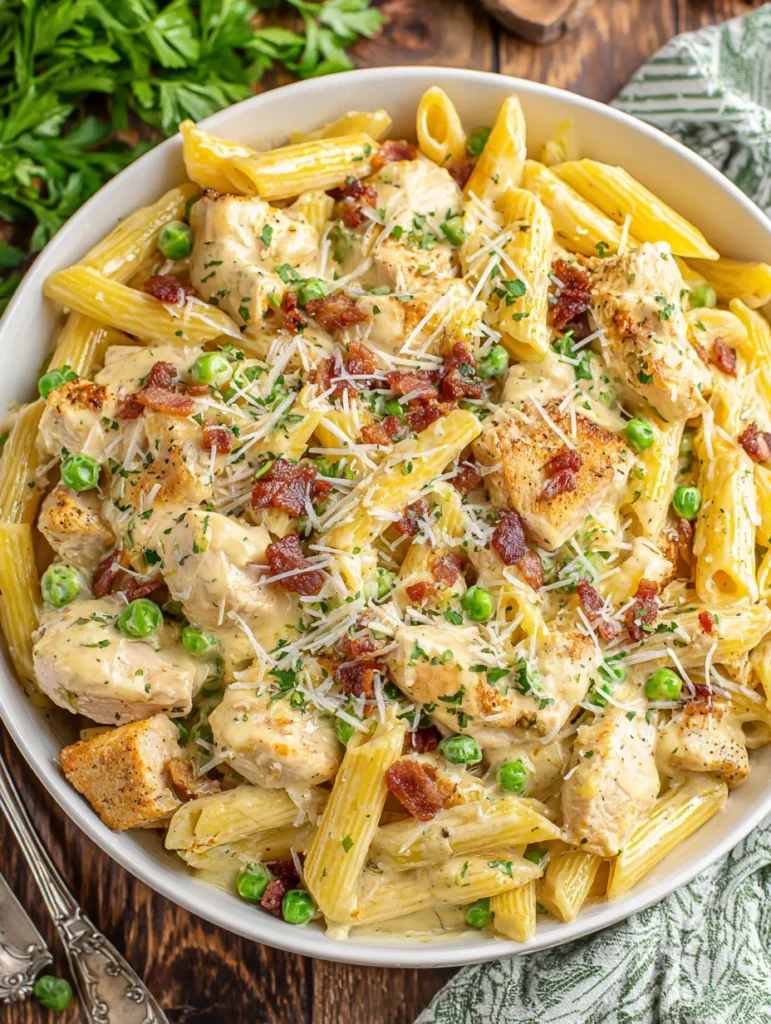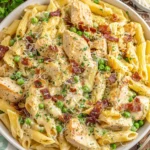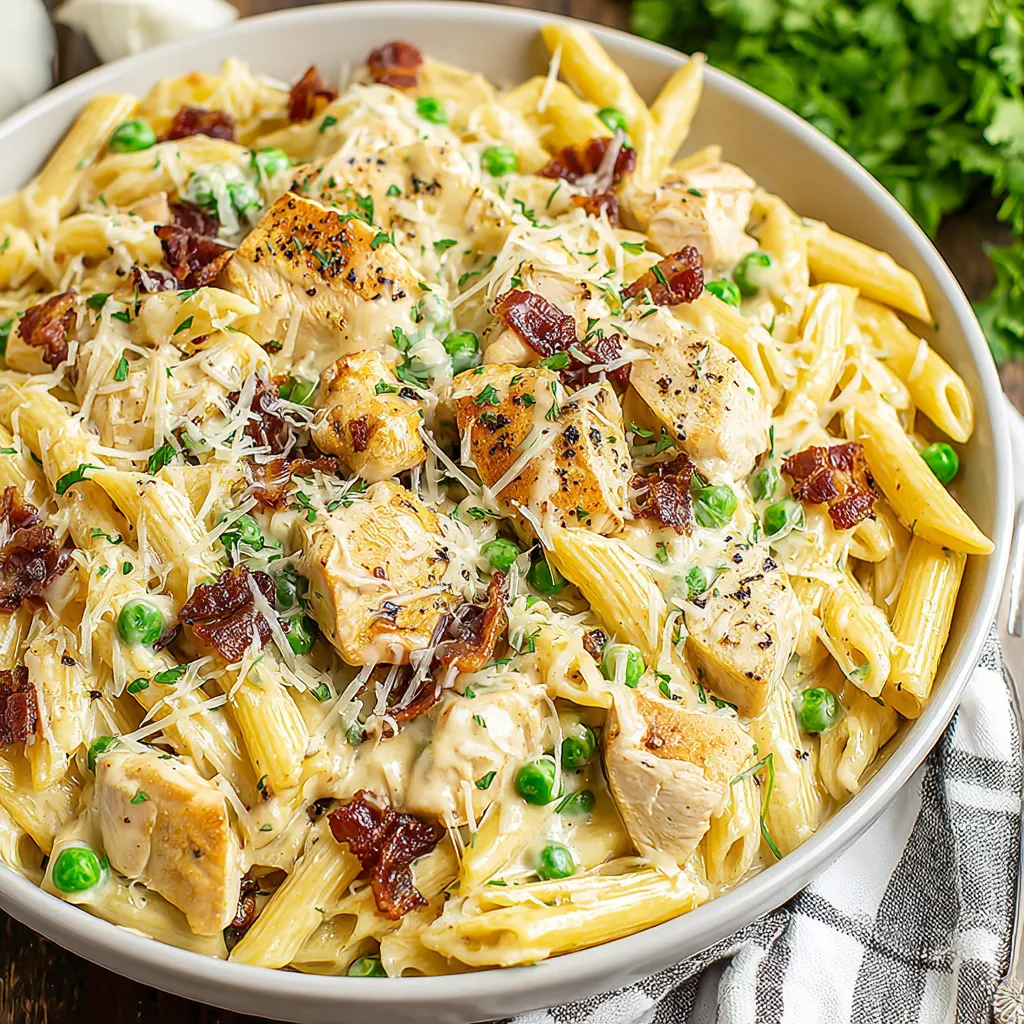Look, traditional carbonara purists are going to have opinions about adding chicken to this classic Roman pasta. But those purists aren’t here right now, and you’re hungry, and chicken makes this a complete meal instead of just carbs and pork. So we’re doing it anyway, and it’s going to be creamy, silky, and absolutely delicious.
Real carbonara doesn’t have cream – it gets its silky texture from egg yolks and pasta water creating an emulsion. It’s basically alchemy where simple ingredients become liquid gold that coats every strand of pasta. We’re keeping that technique because it’s actually easier than making a cream sauce and tastes infinitely better. Then we’re adding chicken because protein is important and also because crispy chicken with creamy pasta is a combination that makes sense.
This isn’t some watered-down Olive Garden situation with heavy cream and a jar of Alfredo. This is the real deal technique with a protein upgrade. It’s rich without being heavy, flavorful without being complicated, and comes together faster than you can argue about authenticity on the internet.
Why This Pasta Is About to Become Your Signature Dish
- No cream required — Eggs and pasta water create magic
- 20 minutes total — Faster than most takeout
- Restaurant-quality technique — But actually easy when you know how
- Crispy bacon AND chicken — Because we’re not choosing sides
- Silky sauce that coats perfectly — No clumps, no scrambled eggs
- Uses pantry staples — Probably have everything already

The Stuff You Need
For the Pasta:
- 1 lb spaghetti or fettuccine (whatever long pasta you have)
- Salt for pasta water (be generous, it should taste like the ocean)
For the Proteins:
- 1 lb boneless, skinless chicken breasts or thighs, cut into bite-sized pieces
- 8 oz bacon or pancetta, diced (bacon is easier to find, pancetta is more traditional)
- 2 tablespoons olive oil
- Salt and black pepper
For the Sauce:
- 4 large egg yolks (save the whites for an omelet tomorrow)
- 1 whole egg
- 1½ cups freshly grated Parmesan cheese (the real stuff, not the green can)
- 1 cup freshly grated Pecorino Romano (or more Parmesan if you can’t find it)
- 4 cloves garlic, minced
- 1-2 cups pasta cooking water (this is crucial, don’t dump it)
- Lots of freshly cracked black pepper (like, an aggressive amount)
For Serving:
- More grated Parmesan
- More black pepper (seriously, carbonara is all about the pepper)
- Fresh parsley, chopped (optional but pretty)
- Red pepper flakes if you like heat
Special Equipment:
- Large pot for pasta
- Large skillet for cooking chicken and bacon
- Large mixing bowl (for combining everything)
- Tongs or pasta fork
- Grater (pre-grated cheese doesn’t melt the same, sorry)
Let’s Make This Pasta That’ll Impress Italian Grandmas (Mostly)
Step 1: The Setup That Prevents Disaster
Get all your ingredients ready before you start cooking. This dish comes together FAST and you don’t want to be grating cheese while your pasta gets cold. Grate your cheese into a large bowl. Separate your egg yolks into the same bowl with the cheese. Add the whole egg. Whisk it all together with a generous amount of black pepper until it looks like a thick, cheesy paste. Set aside.
Step 2: The Pasta Water
Fill your largest pot with water and salt it generously. We’re talking at least 2 tablespoons of salt. The water should taste salty. This is your only chance to season the pasta itself. Bring it to a rolling boil.
Step 3: The Bacon Situation
While the water heats up, cook your diced bacon in a large skillet over medium heat. Let it render and get crispy, stirring occasionally. This takes about 8-10 minutes. You want it golden and crispy, not burnt. Once crispy, use a slotted spoon to remove the bacon to a paper towel-lined plate. Leave about 2 tablespoons of bacon fat in the pan. Pour off the rest or save it for cooking eggs later because bacon fat is liquid gold.
Step 4: The Chicken Cook
Season your chicken pieces with salt and pepper. Add olive oil to the bacon fat in the pan (or just use the bacon fat if there’s enough). Increase heat to medium-high. Add the chicken pieces in a single layer. Let them cook undisturbed for about 3-4 minutes until golden on the bottom, then stir and cook another 3-4 minutes until cooked through. Add minced garlic in the last minute of cooking. Turn off heat. The chicken will stay warm in the pan.
Step 5: Cook the Pasta
Once your water is boiling, add the pasta. Cook according to package directions until al dente. This usually means 1-2 minutes LESS than the package says. Before draining, scoop out at least 2 cups of that starchy pasta water with a measuring cup or mug. This is crucial. DO NOT forget this step. Then drain the pasta.
Step 6: The Emulsion Magic (This Is Where It Gets Good)
Working quickly, add about ½ cup of hot pasta water to your egg and cheese mixture while whisking constantly. This tempers the eggs so they don’t scramble when you add the hot pasta. Keep whisking until smooth. It should look like a thick, pourable sauce.
Step 7: The Combination
Add the hot drained pasta directly to the egg mixture in the bowl. Toss immediately and vigorously with tongs, lifting and turning the pasta so every strand gets coated. The heat from the pasta will cook the eggs just enough to create a creamy sauce. Add more pasta water a little at a time if it seems too thick. You want it silky and sauce-like, not gloppy or dry. This takes about 1-2 minutes of constant tossing.
Step 8: Add the Proteins
Once the sauce is perfect and coating the pasta, add the chicken, bacon, and any garlic bits from the pan. Toss everything together until evenly distributed. If it seems dry, add more pasta water. The sauce should be creamy and coat the pasta completely, not pool at the bottom of the bowl.
Step 9: The Final Seasoning
Taste the pasta. Add more black pepper (you almost certainly need more). Add more grated Parmesan if you want. Adjust salt if needed, though the bacon and cheese are already pretty salty.
Step 10: Serve Immediately
Carbonara waits for no one. Serve it immediately in warm bowls. Top with more Parmesan, more black pepper, and parsley if using. Eat it right away while it’s hot and creamy. Cold carbonara is sad carbonara because the sauce firms up as it cools.
Pro Tips From Someone Who’s Made This Many Times
Temperature Control is Everything: The pasta must be hot when you add it to the eggs. If it’s lukewarm, the sauce won’t emulsify properly.
Don’t Scramble the Eggs: Add pasta water to the egg mixture first to temper it. Toss the pasta off the heat if you’re nervous about scrambling.
Pasta Water is Magic: That starchy water is what makes the sauce silky. Don’t skip it. Use it generously.
Work Quickly: Once you drain the pasta, move fast. The residual heat is what cooks the eggs and creates the sauce.
Real Parmesan Only: Pre-grated cheese has anti-caking agents that prevent it from melting smoothly. Grate it fresh.
Black Pepper is Essential: This isn’t just seasoning – it’s a main flavor component. Use a lot. Crack it fresh.
Don’t Add Cold Cheese: Room temperature cheese melts better. Take it out of the fridge while you cook.
Switch It Up (Because We’re Not Rigid)
Classic Carbonara: Skip the chicken. Use just pancetta or guanciale. Keep everything else the same.
Mushroom Carbonara: Add sautéed mushrooms with the chicken. Earthy and delicious.
Peas and Chicken: Add frozen peas in the last minute of pasta cooking. Bright green and sweet.
Spicy Carbonara: Add red pepper flakes with the garlic. Use spicy Italian sausage instead of chicken.
Shrimp Carbonara: Replace chicken with shrimp. Cook for 2-3 minutes until pink.
Vegetarian Version: Skip the bacon and chicken. Use extra cheese and add roasted vegetables.
Truffle Carbonara: Add a drizzle of truffle oil at the end. Very fancy, very expensive, very worth it.
Make-Ahead Reality Check
The Proteins: Cook chicken and bacon up to 2 days ahead. Reheat gently when ready to assemble.
The Sauce: Cannot be made ahead. The egg mixture must be combined with hot pasta fresh.
The Pasta: Cook fresh. Leftover pasta doesn’t work well because you need that hot pasta to cook the eggs.
Meal Prep Truth: This doesn’t reheat well. The sauce breaks and becomes clumpy. Make it fresh or don’t make it.
Questions People Always Ask
Q: My sauce is clumpy and scrambled. What happened? A: The eggs got too hot. Next time, temper them with pasta water first and toss the pasta off the heat.
Q: My sauce is too thick and gloopy. A: Not enough pasta water. Add more, a little at a time, while tossing until it reaches the right consistency.
Q: Can I use heavy cream? A: You can, but then it’s not carbonara. It’ll be good but different. The egg-based sauce is lighter and actually easier.
Q: What if I don’t have Pecorino Romano? A: Use all Parmesan. It’ll be slightly less tangy but still delicious.
Q: Can I use turkey bacon? A: You can, but it won’t be as flavorful. Regular bacon or pancetta is really worth it here.
Q: Why is fresh Parmesan so important? A: Pre-grated cheese has cellulose powder to prevent clumping. This prevents it from melting smoothly into the sauce.
Storage Real Talk
Leftovers: Store in the fridge for up to 2 days, but the sauce will break and get clumpy. Reheat gently with a splash of cream or pasta water.
Freezing: Don’t. The egg-based sauce doesn’t freeze well. Eat it fresh.
Best Practice: Only make what you’ll eat. This dish doesn’t improve with time.
Reheating: Microwave gently with a splash of milk or cream to bring back some creaminess, but it’ll never be the same as fresh.
Perfect Pairings
Salad: Simple arugula salad with lemon vinaigrette to cut through the richness.
Bread: Garlic bread for soaking up extra sauce. Carbs on carbs is fine.
Wine: White wine like Pinot Grigio or a light red like Chianti.
Vegetables: Roasted asparagus or broccolini on the side.
Nothing: This is a complete meal. You don’t need sides unless you want them.
The Science of the Emulsion
When you combine hot pasta with the egg and cheese mixture, the residual heat from the pasta gently cooks the eggs while the starchy pasta water helps emulsify everything into a smooth sauce. The cheese melts and combines with the eggs and starch to create a silky coating.
This is a temperature-controlled emulsion – too hot and the eggs scramble, too cold and the sauce doesn’t come together. The pasta water’s starch acts as an emulsifier, helping the fat from the cheese and eggs combine with the water into a stable, creamy sauce.
It’s the same principle as making mayonnaise – you’re combining fat and water-based ingredients that normally don’t mix, but the emulsifying agent (egg yolks and starch) brings them together into something smooth and cohesive.
When to Make This Dish
Date Night: Impressive but not complicated. Perfect for showing off.
Quick Weeknight Dinner: 20 minutes and tastes like you tried harder.
Dinner Party: Make it table-side for maximum drama and impressiveness.
Comfort Food Night: Rich, satisfying, and exactly what you need.
Sunday Dinner: When you want something special but don’t want to spend all day cooking.
Anytime You Want to Feel Fancy: Carbonara is always an occasion.
Why This Works So Well
Carbonara is one of those dishes that seems intimidating but is actually pretty simple once you understand the technique. The key is respecting the heat – hot enough to cook the eggs into a sauce, not so hot that they scramble. The chicken addition makes it more substantial without compromising the technique or flavor.
It’s also incredibly satisfying. The combination of salty bacon, tender chicken, creamy sauce, and pepper-forward pasta hits all the right notes. It feels indulgent without being heavy because there’s no cream weighing it down. The egg-based sauce is rich but light, coating the pasta perfectly without being gloppy.
This is the pasta that makes people think you’re a better cook than you are. It’s the dish that proves technique matters more than complicated ingredients. It’s the meal that shows how a few simple, quality ingredients treated properly can create something spectacular.
Chicken carbonara proves that sometimes traditions can be adapted without losing what makes them special. The Romans might raise an eyebrow at the chicken, but they’d recognize the technique, respect the execution, and probably have seconds anyway.
This is what happens when you take a classic, understand why it works, and make it your own. And honestly? That’s what good cooking should be.
Print
Chicken Carbonara
- Total Time: 25 minutes
- Yield: 4–6 servings 1x
Description
Look, traditional carbonara purists are going to have opinions about adding chicken to this classic Roman pasta. But those purists aren’t here right now, and you’re hungry, and chicken makes this a complete meal instead of just carbs and pork. So we’re doing it anyway, and it’s going to be creamy, silky, and absolutely delicious.
Real carbonara doesn’t have cream – it gets its silky texture from egg yolks and pasta water creating an emulsion. It’s basically alchemy where simple ingredients become liquid gold that coats every strand of pasta. We’re keeping that technique because it’s actually easier than making a cream sauce and tastes infinitely better. Then we’re adding chicken because protein is important and also because crispy chicken with creamy pasta is a combination that makes sense.
This isn’t some watered-down Olive Garden situation with heavy cream and a jar of Alfredo. This is the real deal technique with a protein upgrade. It’s rich without being heavy, flavorful without being complicated, and comes together faster than you can argue about authenticity on the internet.
Ingredients
For the Pasta:
- 1 lb spaghetti or fettuccine (whatever long pasta you have)
- Salt for pasta water (be generous, it should taste like the ocean)
For the Proteins:
- 1 lb boneless, skinless chicken breasts or thighs, cut into bite-sized pieces
- 8 oz bacon or pancetta, diced (bacon is easier to find, pancetta is more traditional)
- 2 tablespoons olive oil
- Salt and black pepper
For the Sauce:
- 4 large egg yolks (save the whites for an omelet tomorrow)
- 1 whole egg
- 1½ cups freshly grated Parmesan cheese (the real stuff, not the green can)
- 1 cup freshly grated Pecorino Romano (or more Parmesan if you can’t find it)
- 4 cloves garlic, minced
- 1–2 cups pasta cooking water (this is crucial, don’t dump it)
- Lots of freshly cracked black pepper (like, an aggressive amount)
For Serving:
- More grated Parmesan
- More black pepper (seriously, carbonara is all about the pepper)
- Fresh parsley, chopped (optional but pretty)
- Red pepper flakes if you like heat
Special Equipment:
- Large pot for pasta
- Large skillet for cooking chicken and bacon
- Large mixing bowl (for combining everything)
- Tongs or pasta fork
- Grater (pre-grated cheese doesn’t melt the same, sorry)
Instructions
Get all your ingredients ready before you start cooking. This dish comes together FAST and you don’t want to be grating cheese while your pasta gets cold. Grate your cheese into a large bowl. Separate your egg yolks into the same bowl with the cheese. Add the whole egg. Whisk it all together with a generous amount of black pepper until it looks like a thick, cheesy paste. Set aside.
Fill your largest pot with water and salt it generously. We’re talking at least 2 tablespoons of salt. The water should taste salty. This is your only chance to season the pasta itself. Bring it to a rolling boil.
While the water heats up, cook your diced bacon in a large skillet over medium heat. Let it render and get crispy, stirring occasionally. This takes about 8-10 minutes. You want it golden and crispy, not burnt. Once crispy, use a slotted spoon to remove the bacon to a paper towel-lined plate. Leave about 2 tablespoons of bacon fat in the pan. Pour off the rest or save it for cooking eggs later because bacon fat is liquid gold.
Season your chicken pieces with salt and pepper. Add olive oil to the bacon fat in the pan (or just use the bacon fat if there’s enough). Increase heat to medium-high. Add the chicken pieces in a single layer. Let them cook undisturbed for about 3-4 minutes until golden on the bottom, then stir and cook another 3-4 minutes until cooked through. Add minced garlic in the last minute of cooking. Turn off heat. The chicken will stay warm in the pan.
Once your water is boiling, add the pasta. Cook according to package directions until al dente. This usually means 1-2 minutes LESS than the package says. Before draining, scoop out at least 2 cups of that starchy pasta water with a measuring cup or mug. This is crucial. DO NOT forget this step. Then drain the pasta.
Working quickly, add about ½ cup of hot pasta water to your egg and cheese mixture while whisking constantly. This tempers the eggs so they don’t scramble when you add the hot pasta. Keep whisking until smooth. It should look like a thick, pourable sauce.
Add the hot drained pasta directly to the egg mixture in the bowl. Toss immediately and vigorously with tongs, lifting and turning the pasta so every strand gets coated. The heat from the pasta will cook the eggs just enough to create a creamy sauce. Add more pasta water a little at a time if it seems too thick. You want it silky and sauce-like, not gloppy or dry. This takes about 1-2 minutes of constant tossing.
Once the sauce is perfect and coating the pasta, add the chicken, bacon, and any garlic bits from the pan. Toss everything together until evenly distributed. If it seems dry, add more pasta water. The sauce should be creamy and coat the pasta completely, not pool at the bottom of the bowl.
Taste the pasta. Add more black pepper (you almost certainly need more). Add more grated Parmesan if you want. Adjust salt if needed, though the bacon and cheese are already pretty salty.
Carbonara waits for no one. Serve it immediately in warm bowls. Top with more Parmesan, more black pepper, and parsley if using. Eat it right away while it’s hot and creamy. Cold carbonara is sad carbonara because the sauce firms up as it cools.
Notes
Temperature Control is Everything: The pasta must be hot when you add it to the eggs. If it’s lukewarm, the sauce won’t emulsify properly.
Don’t Scramble the Eggs: Add pasta water to the egg mixture first to temper it. Toss the pasta off the heat if you’re nervous about scrambling.
Pasta Water is Magic: That starchy water is what makes the sauce silky. Don’t skip it. Use it generously.
Work Quickly: Once you drain the pasta, move fast. The residual heat is what cooks the eggs and creates the sauce.
Real Parmesan Only: Pre-grated cheese has anti-caking agents that prevent it from melting smoothly. Grate it fresh.
Black Pepper is Essential: This isn’t just seasoning – it’s a main flavor component. Use a lot. Crack it fresh.
Don’t Add Cold Cheese: Room temperature cheese melts better. Take it out of the fridge while you cook.
- Prep Time: 10 minutes
- Cook Time: 15 minutes
Nutrition
- Calories: ~680 kcal
- Fat: ~28g
- Carbohydrates: ~62g
- Protein: ~42g

